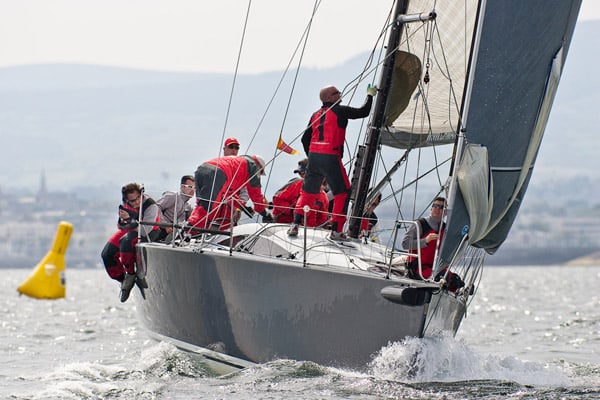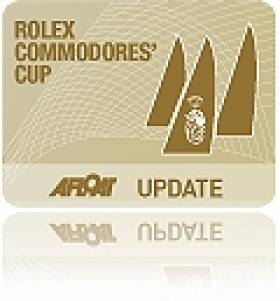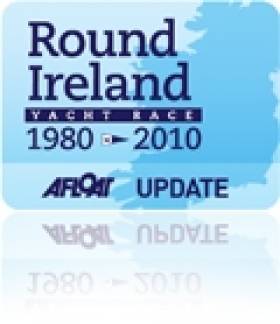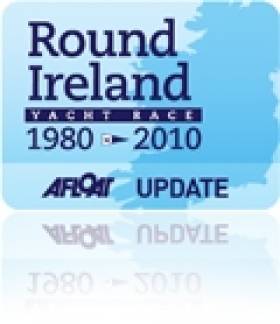Displaying items by tag: Mike Broughton
'Tough & Challenging Round Ireland Race Ahead', Says Sailing Forecaster Mike Broughton
Specialist sailing weather forecaster Mike Broughton of winningwind.com says tomorrow's Round Ireland Race will be a tough and challenging one
‘Looks like we have light sea breezes for the start in fine and sunny conditions – but it’s all going to change.
For start time we have a ridge of high pressure over Wicklow bringing a light sea breeze that will veer to south westerly winds increasing 12-17 knots by early evening, giving a beat south towards Tuskar Rock. Then we have unsettled conditions from midnight as the first of possibly seven fronts to pass the fleet over the next four days. The first warm front will bring light rain and SW winds of 9-15 knots – still giving a beat along the south coast.
By Sunday afternoon, we have a complex, mid Atlantic low pressure system that will dominate the weather from Sunday to Tuesday, bringing several fronts, with rain and winds to gale force mainly from the south west to west-south-west. It looks like a tough and challenging beat on Sunday afternoon/evening around the Fastnet area, particularly for the smaller boats. We can expect winds to 40 knots and seas 3.5 to 4.0 metres.
The low pressure looks to deepen through Sunday and by midnight is forecast to be 300 miles south of Iceland and will then start to slowly fill. Leaving most of the fleet in WSW winds along the west coast on Monday morning, giving fast reaching conditions north, still in waves around 3.5 metres. Winds for Monday afternoon to Tuesday evening still look to be strong (mainly 24-34 knots) from the WSW and giving fast broad reaching conditions across the north coast. Whilst winds on the NE coast will be lighter in the lee of the mainland. Winds east of Dublin will be down to 10 knots by Thursday – mainly from WSW to SW.
Overall, it looks like a tough and challenging race, with plenty of opportunities to make gains from the predictable shifts from passing fronts. Rough seas close to the Fastnet and all along the west coast.
Best of luck to my many friends out there doing the race – it will be one to remember!
Commodores Cup: Send YOUR Good Luck Wishes HERE!
MANY OF YOU SENT GOOD LUCK WISHES AND NOW YOU CAN SAY WELL DONE TOO! SCROLL DOWN THE PAGE TO LEAVE YOUR CONGRATULATION MESSAGE!

The ICRA Team Celebrations in Cowes, Photo: David Branigan
After a series of near misses in the Commodores Cup, there are many reasons why 2010 was an entirely appropriate timing for an Irish win in Cowes today.
Ireland's single three boat team (below) faced stiff opposition in the final ten team line up. Individual performances this season though, including a win at the British IRC Nationals, is proof, were it needed, that Ireland still was always on course to win the Commodores Cup.
Ireland's team on the Solent was Royal Cork based; Antix, Anthony O'Leary (Ker 39); Marinerscove.ie David Dwyer (Mills 39) and Roxy 6 Robert Davies (Corby 36). The full crew list for each boat is below, representing the very best of Irish sailing talent.
Third time lucky is how it was scripted in 08, but not how it was acted out. After first being jilted by the French and now, for the second time, by the English, the Irish could be forgiven for giving up on the cup but we never did. This victory represents the final week of eight months preparation for superb assault on the title.
PLEASE SCROLL DOWN TO THE END OF THE PAGE AND LEAVE YOUR CONGRATULATIONS MESSAGE!

Team Ireland 2010 Commodores Cup
Photos by Robert Bateman
IRL3939 Antix Anthony O'Leary (Ker 39)

Anthony O'Leary (IRL)
David Lenz (GBR)
Peter O'Leary (IRL)
Ross Deasy (IRL)
Brian Lennon (IRL)
Stephen O'Sullivan (IRL)
Eoin Leahy (IRL)
Frederick Cudmore (IRL)
Simon Johnson (IRL)
Rory O'Sullivan (IRL)
Jimmy Houston (GBR)
Derek Moynan (IRL)
Tom Durcan (IRL)
Robert O'Leary (IRL)
Darragh O'Connor (IRL)
IRL39000 Marinerscove.ie David Dwyer (Mills 39)

Andy Beadsworth (GBR)
David Bolton (IRL)
Padraig Byrne (IRL)
Alan Curran (IRL)
David Dwyer (IRL)
Bernard Fitzpatrick (IRL)
Brian Heneghan (IRL)
David Love (IRL)
Tom Murphy (IRL)
Nicholas O'Leary (IRL)
Clive O'Shea (IRL)
Sandy Rimmington (IRL)
Chris Schirmer (GBR)
Don Wilson (IRL)
IRL36000 Roxy 6 Robert Davies (Corby 36)

Rob Davies (GBR)
Andrew Creighton (IRL)
Marty O'Leary (IRL)
Jim Hughes (IRL)
Paul Farries (GBR)
Nelson Moore (IRL)
Tom Whitburn (GBR)
Michael Liddy (IRL)
Aidan O'Connell (IRL)
Maurice O'Connell (IRL)
Team Management:
Barry Rose, Fintan Cairns, Denis Kiely, Mike Broughton and Norbert Reilly
- RORC
- Anthony O'Leary
- Norbert Reilly
- ICRA
- Eoin Leahy
- Maurice O'Connell
- Commodores Cup
- Fintan Cairns
- Peter O'Leary
- antix
- Mike Broughton
- roxy 6
- Mariners Cove
- David Lenz
- Ross Deasy
- Brian Lennon
- Stephen O'Sullivan
- Frederick Cudmore
- Simon Johnson
- Rory O'Sullivan
- Jimmy Houston
- Derek Moynan
- Tom Durcan
- Robert O'Leary
- Darragh O'Connor
- Andy Beadsworth
- David Bolton
- Padraig Byrne
- Alan Curran
- David Dwyer
- Bernard Fitzpatrick
- Brian Heneghan
- David Love
- Tom Murphy
- Nicholas O'Leary
- Clive O'Shea
- Sandy Rimmington
- Chris Schirmer
- Don Wilson
- Rob Davies
- Andrew Creighton
- Marty O'Leary
- Jim Hughes
- Paul Farries
- Nelson Moore
- Tom Whitburn
- Michael Liddy
- Aidan O'Connell
- Barry Rose
- Denis Kiely
Podcast: Strong Winds on Wednesday Morning
Up to 30 knot winds will sweep the Round Ireland fleet up the west coast for a time tomorrow morning. This latest wind news (and much more) is in weather guru, Mike Broughton's latest weather observations in the podcast below. The fleet head for the north coast and the second half of Round Ireland 2010 tomorrow, edging closer to Inistrahull, a notorious landmark where many previous races effectively restarted. Tonnerre be warned!
Stronger winds will bring the Round Ireland 2010 fleet home earlier than expected and it will be a fascinating, tactical race, says Wind guru Mike Broughton. The Irish Commodore's Cup team weather specialist says the 37 competitors in today's Round Ireland race will get a close hauled course along the south coast to the Fastnet tomorrow. After light northerly winds for the start at 12 noon today the fleet can expect winds to go southwest by 8pm. Mike's podcast prediction is below. Listen in!
More on the Round Ireland Yacht Race:
Round Ireland Yacht Race 2010 Review
Round Ireland Yacht Race, Ireland's top offshore fixture
A Round up of 80 stories on the 2010 Round Ireland Yacht RaceAlthough five days out is still early enough for a forecast, the start of the 30th anniversary Round Ireland Yacht Race looks like it is going to get off to a gentle start. Specialist wind forecaster Mike Broughton says Sunday's noon start maybe yet be a drifter because a large high pressure is setting up for Ireland and will be centred about 230 miles to the west of the country.
Although light northerlies may prevail there is also a chance of light sea breezes both on Sunday and Monday afternoon. Broughton, who is the Irish Commodores Cup team weather forecaster, says the fleet can expect more light southerly winds as it races along the south coast on Monday.
Afloat.ie has teamed up with specialist sailing forecaster Mike Broughton of Winning Wind.Com to bring you a series of detailed Round Ireland race forecasts. Click back to the home page for regular weather updates from Mike.
More on the Round Ireland Yacht Race:
Round Ireland Yacht Race 2010 Review
Round Ireland Yacht Race, Ireland's top offshore fixture
A Round up of 80 stories on the 2010 Round Ireland Yacht Race
































































